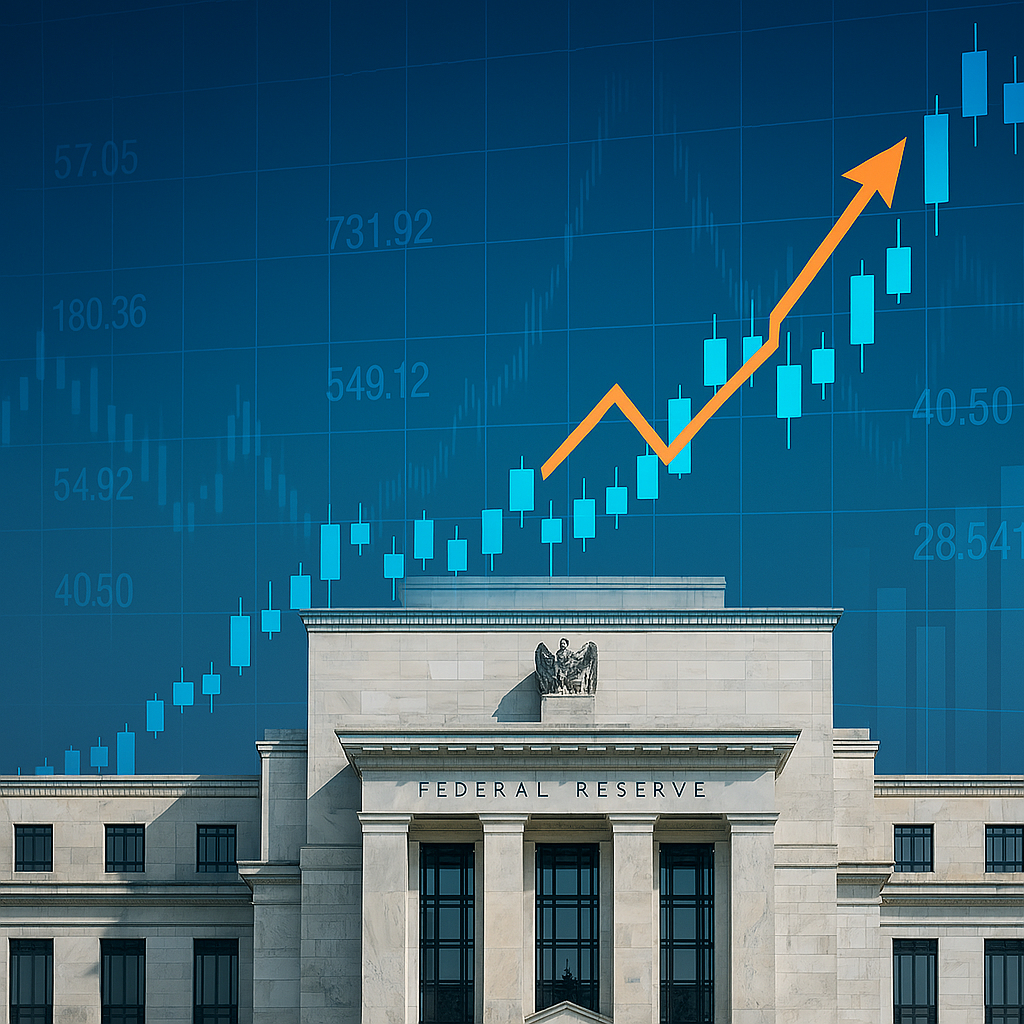📌 Table of Contents
- Markets Resilient in a Volatile World: Introduction
- Israel-Iran Conflict: Risk Without Panic
- Fed Meeting: What Financial Markets Are Watching
- Sector Performance: Tech, Energy and Defense
- 3 Why U.S. Stocks Are Rising Even When the World Looks Troubling
- Context: What History Tells Us About Markets and Geopolitical Crises
- Investor Psychology: Why This Market Isn’t Being Driven by Fear
- Smart Strategies for Navigating Uncertainty
- Key Takeaways for Investors
- Q&A: Your Top Questions Answered
- Final Thoughts: Confidence Over Crisis
🧭 Intro: Market Resilience in a Volatile World
us stocks gain across major indexes this week, despite geopolitical turmoil and economic uncertainties. The S&P 500, the Nasdaq composite and the Dow Jones Industrial Average all ended the day higher, against forecasts that the Israel-Iran standoff and a closely watched Federal Reserve meeting could knock markets down.
This surprising strength raises a crucial question: Why are U.S. stocks going up when the world’s lowest-odds geopolitical and economic outcome is on the table?
It comes down to a potent mix of robust corporate fundamentals, investorsexibility and a reframing of the macroeconomic narrative that tilts toward long-run optimism instead of short-run panic.

🌍Israel-Iran Conflict: Risk Without Hysteria
The rising tension between Israel and Iran ruffled global markets for a moment, particularly oil and defense industries. However, investor panic was short-lived.
“Markets are assimilating a certain amount of geopolitical risk,” said Laura Benson, chief investment officer at GlobalEdge Capital.
Key Insights:
- Oil prices surged early in the week, but recovered quickly.
- Shares of defense stocks such as Lockheed Martin and Northrop Grumman rose.
- Investors seem to be betting the conflict will stay regional.
Humanitarian and political considerations aside, financial markets’ reaction looks to be more circumspect than fearful. That is, the market is making a distinction between headline risk and systemic economic damage.
🏦 Fed Meeting: What Investors Are Looking For
Geopolitical risks may be in the headlines, but on Wall Street all eyes are fixated on the Federal Reserve’s looming policy decision. Now, with signs that inflation is cooling, investors will look for a dovish tone.

What’s at Stake:
- The Fed is expected to leave interest rates unchanged, according to most analysts.
- A dovish signal could be good for tech and growth stocks.
- Sudden hawkish can spark volatility in the short run.
📌 Key Insight: It’s not just what the Fed decides, but how it communicates that will decide whether U.S. stocks keep rallying or see a pullback.
📈 3 Reasons U.S. Stocks Are Rising in the Middle of a Pandemic
Here’s why us stocks gain even as the world is in chaos:
Strong Corporate Earnings
Large companies like Apple, Microsoft and Meta exceeded estimates, which lifted investor confidence. Earnings season has brought better-than-expected results, especially in some technology and consumer discretionary companies.
Cooling Inflation
Core PCE inflation fell to 2.8%, its weakest in a bit more than two years — easing pressure on the Fed. This has raised the possibility that the central bank could pause or even cut rates later this year.
Market Adaptability
Investors have grown immune to geopolitical shocks, focusing on long-term fundamentals. In contrast to previous decades, the markets of today are more algorithm driven and less responsive to short-term news cycles.

🕰️ Historical Context: How Markets Respond to Conflict
Markets tend to rebound from geopolitical shocks:
- The Americans stocks picked up again within weeks after the Gulf War in 1991.
- In the Russia-Ukraine standoff, markets fell at first and then recovered.
- The S&P 500 rebounded within months even after 9/11.
📌 Insight: Unless there are major disruption of global trade or supply chains, markets tend to rebound quickly.
🧠 Investor Psychology: Embracing Resilience Over Fear
It’s also worth mentioning that while the VIX (Volatility Index) remains low, meaning that investors are not panicking. Why?
- It lessens the unknown with actual data, at any given moment.
- Algorithmic trading also tends to level out emotional responses.
- More people have become long-term investors.
📌 Spotlight on the Key Word: This change in psychology is one reason American stocks go up even in the midst of global crises.

“This shift in mindset is one reason us stocks gain even when fear dominates the headlines.”
💼 Smart Solutions for Volatile Times
When us stocks gain surge amid global uncertainty, what should investors do?
✅ Spread the risk across sectors and asset classes
✅Look at Good Quality Stock with Good Fundamentals
✅ Mitigate the timing risk with dollar-cost averaging
✅ Don’t panic sell during short-term dips
✅ Review defensive sectors, such as health care and utilities
📌 Pro Tip: View volatillity as a buying opportunity, not as an excuse to run.
🧾 Key Takeaways for Investors
- Strong earnings, moderated inflation and malleable market push us stocks gain higher
- Fed communication is more important than the rate cut itself
- Markets are pricing in geopolitical risk, not panicking about it
- Diversity and dicipline are key to long term success
“The fact that us stocks gain despite global instability reflects deep investor confidence.”
Market Insights All Investors Need to Know
- Resilience Is the New Normal
us stocks gain even when the country’s geopolitical sovereignty is assaulted and investors have no idea what people who have no experience will do, because markets are becoming more forward-looking. Long-term fundamentals are being priced in by investors, not simply a response to headlines. - The Fed’s Message Is More Important Than Its Move
us stocks gain not only if the Fed hikes or takes the pause button, but how they telegraph this. Growth stocks can lift on a dovish tone, while short-term volatility can ensue on hawkish language. - Geopolitical Risk ≠ Market Collapse
us stocks gain because history has shown that markets can quickly rebound after geopolitical events. Unless global trade or supply chains are meaningfully disrupted, investors typically take the longer view and look through the noise. - Earnings Still Drive the Market
us stocks gain on robust corporate profits — especially in the tech/FAANG and consumer behemoth realm — which is one of the major reasons U.S. stocks rise. Earnings season still matters in a big way for market direction. - Retail Investors Are Savvier Than Ever
us stocks gain as the availability of real-time data, diverse ETFs, and algorithmic instruments enables retail investors to be more educated and less jittery. This change is providing some stability to markets in tumultuous times.
❓ Q&A: Your Questions, Answered
Read more of our coverage on Facebook: Your Facebook (Real) Friends
Read more of our coverage on Facebook: Your Facebook (Real) Friends 1.
Q: Is now the time to buy defense stocks?
A: Defense shares are on the upswing, but defense stocks should be part of a diversified portfolio.
Q: Will the Fed lower rates this year?
A: Maybe, but the Fed is probably going to wait for additional information. A short-term hiatus is more likely.
Q: Is it safe to invest while there are geopolitical crises happening around the world?
A: Historically, yes. Markets typically bounce back swiftly unless conflicts spread globally.
Q: Which industries stand to gain from increasing geopolitical risk?
A: Defense, energy and cybersecurity can benefit in times of conflict.
Q: What can I do to shield my portfolio from volatility?
A: Defer to stop-loss orders, diversify positions rather than concentrate, and take a long-term view.
Q: Should I time the market and wait for a dip to invest?
A: It’s hard to time the market. Consider using dollar-cost averaging to mitigate risk.
🧭 Last thing: Confidence, not Crisis
That stocks in the United States are up, even as both economic and geopolitical uncertainty are high stakes, is a show of market resilience. Some risks persist — Middle East tensions, Fed policy shifts — but investor sentiment is robust.
📌 Stay informed, stay diversified and stay focused on the long term.
🔗 Resources & Links
- Federal Reserve Economic Data (FRED) – DoFollow
- MarketPulse by OANDA – DoFollow
- Globe Finance Hub – Market News – Internal Link
